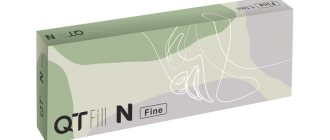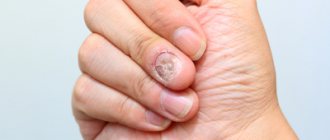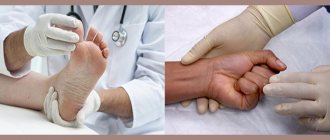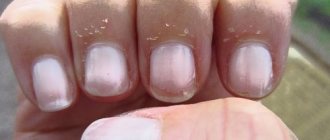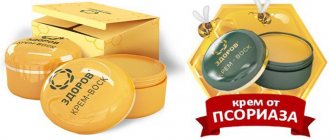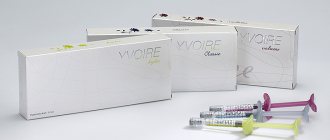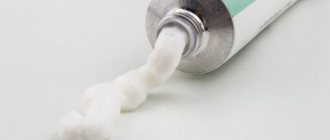Girls' fingers are a very important area on their body, since their tips contain a lot of nerve points and endings, which connects them with the whole body. The condition of a pedicure and manicure often reveals internal problems of the body, which are important to pay attention to.
If a girl’s toenail turns white, it is important to immediately consult a doctor, since the appearance of strong pigmentation may indicate the presence of severe malfunctions, the absence of treatment of which can lead to severe malfunctions.
Why are there white spots on fingernails and toenails?
Many girls believe that white toenails are much less common than hands, but this is due to the fact that we always see the state of the manicure, and the feet are often hidden under socks or shoes.
Natural pedicure damage is very dangerous for anyone, as it is often caused by internal factors that need to be treated and eliminated.
Another name for pigmentation on the legs is leukonychia. It is not a disease, but it can negatively affect a woman’s health if its treatment and elimination of symptoms are neglected.
Leukonychia is most dangerous when the formation of white spots or stripes on the surface becomes an alarming signal from the body, which indicates the presence of diseases or problems in the girl’s body.
There are usually two types of such pigmentation:
- True. Appears as an alarm signal from the body when organ failures or dysfunction occur.
- False. It is a manifestation of the symptoms of any pathogens, the neutralization of which helps eliminate spots.
Visually, you will not be able to figure out what type of spots appear on your nails, so you need to consult a doctor to find out the cause of such symptoms.
Most often, leukonychia on the legs is harmless, as it appears due to a lack of vitamins in the body - this is the most common reason for the formation of spots. However, to find out the real reason for the formation of this type of pigmentation, you need to undergo an examination.
There are four types of symptoms:
- Limited. Appears in the form of one or two spots on one or several nails, which are located in a chaotic manner.
- Spot. On all toes of one foot and as the nail plate grows, they are at the same level relative to each other. Typically appear due to leg injury.
- Striped. It implies the formation on the nail bed not of dots, but of entire stripes. As a standard, they appear in a chaotic order, but on almost all nails.
- Absolute. It is impossible to distinguish individual spots - the entire nail becomes white or grayish.
The first type of leukonychia can occur in everyone, it is the most harmless and safe, the second type usually appears due to mechanical effects on the legs and does not require special treatment. And stripe and absolute pigmentation are the most dangerous types, as they appear when there are problems in the body.
Signs of fungus damage to the nail plate
If you notice the following manifestations on your nails, then it’s time to sound the alarm:
- Yellowish tint
- Delamination, destruction or thickening
- Blotches of yellow or white spots
- Unpleasant odor, pain
- Changing shape
Given the variety of types of fungus, the infection in its first manifestations may look different.
For example, yeast fungi make the tone of the nail plate darker and add a yellowish color. The nail becomes deformed and takes on a wavy shape. Redness forms on the skin around the nail and even with slight exposure painful sensations appear.
Dermatophytes, affecting the nail, first appear as small spots along the edges of the plate of yellow, white and gray color. Subsequently, the nail completely turns yellow and moves away from the base.
Molds most often attack against the background of reduced immunity. It is difficult to confuse lesions with this species due to the rich palette of colors on the nails: green, blue, black, brown, yellow. Sometimes, already at the first stage, peeling and separation of the nails from the base are observed.
Causes
To find out the main reason why light spots or stripes appear on your nails, you need to see a doctor and get a diagnosis. For this purpose, several tests are usually prescribed, based on the results of which a diagnosis is made and a treatment regimen is prescribed.
You can usually contact three specialists with a problem:
- Surgeon. The first thing you can do is contact him so that he can make an approximate diagnosis, taking into account external and internal factors, and prescribe treatment or refer you to another, more specialized specialist.
- Dermatologist. The doctor who deals with the skin will also find out whether there are internal or external causes for the formation of symptoms, and then, based on this, prescribe treatment.
- Mycologist. You need to contact him if you know that the cause of white spots is a fungal infection. He will prescribe you a comprehensive treatment that will prevent further progression of the disease.
It is not recommended to contact a cosmetologist with a problem on the legs, since the specialist will not be able to find out whether there are internal causes of the lesion, but will only make hypotheses about external cosmetic defects.
There are two types of reasons for the appearance of white spots: internal and external. The first type implies the presence of problems in the body or dysfunction of organs, the second - the influence of external factors, the neutralization of which eliminates the symptoms.
There are several external reasons:
- Mechanical damage. If there is a recent injury to the legs or fingers (bruise, pinching), blood circulation and metabolism in this area are reduced, which leads to many injuries;
- Illiterate manicure. Regardless of where you do it and how, often white pigmentation appears after working with the nail and processing it;
- Frostbite. If you neglect to put on warm shoes in the cold season, your feet may freeze, which is why leukonychia appears;
- Neglect of using individual shoes in saunas, public showers, and water parks. This often leads to a fungal infection of the feet, which affects many symptoms.
A common cause of complete destruction of the nail, including the formation of leukonychia, especially on the feet, is a fungus. Because of this, it is important to consult a doctor, as pathogenic bacteria multiply quickly and the disease progresses.
There are many more internal reasons:
- Hormonal imbalances;
- Dysfunction of the liver, kidneys, gastrointestinal tract;
- Low metabolism;
- Low immunity;
- Unstable emotional state – stress turning into depression;
- Infectious diseases;
- Inflammatory processes, regardless of their causative agent;
- Nervous system lesions.
Also keep in mind that taking some serious medications and antibiotics can affect a woman’s hormonal levels, which can cause pigmentation on her legs.
Stages of development
Initially, nail fungi may manifest as mild itching in the affected area, dry skin, redness and peeling.
The symptoms are not very disturbing at the initial stage, and visually, without consulting a dermatologist, podologist or mycologist, onychomycosis can be confused with other diseases with similar manifestations. This stage can last up to several years. The infection is then revealed by a noticeable yellowing of the nails around the edges. Small cracks and other damage may form on the nails, the skin near them, and between the toes.
The bottom layer of the nail plate becomes looser, and the nail itself becomes exfoliated and thinner.
Cracks in the skin become larger, cause severe pain, an unpleasant smell and appearance create discomfort, nails are destroyed and deformed, and become black. In case of inaction, nail loss is possible.
Treatment for white toenails
Regardless of the reason for the formation of white or dark spots on the nails or their deformation, it is important to begin treatment immediately to prevent the progression of pigmentation and damage to the natural nail.
To begin eliminating the resulting spots or stripes, you first need to perform a diagnosis to determine the causative factor of leukonychia. To do this, you need to contact one of three doctors:
- Surgeon. You can get a general consultation from him, take the necessary tests and get a diagnosis. The doctor either prescribes a treatment regimen or refers you to a more specialized specialist.
- Dermatologist. He deals with skin diseases, so regardless of the cause of the lesion, he makes a diagnosis and prescribes treatment.
- Mycologist. You need to contact him if the cause of leukonychia is a fungal infection, one of the symptoms of which is the appearance of white spots.
To find out why your toenails have become lighter, it is not recommended to contact a cosmetologist, since he will only evaluate the external problem, without taking into account internal factors that may affect the condition of a natural pedicure.
A girl, regardless of the doctor she visits, needs three types of tests:
- General blood test and biochemical;
- Scraping the affected area;
- Spectral analysis, which shows the type of microorganisms on the coating.
Testing can take up to ten days, after which the doctor can draw a conclusion about the cause of leukonychia and prescribe a treatment regimen. It directly depends on the type of lesion.
If the cause of pigmentation is a fungal infection, recovery includes the use of antifungal external drugs: Exoderil, Mycoderil, Lamisil, Mycosan, etc. In advanced forms of infection, oral tablets are additionally prescribed to eliminate inflammatory processes in the body.
If the reason is a lack of vitamins in the body and the matrix itself, the girl is prescribed vitamin complexes and compositions such as Pantovigar, which quickly fill the deficiencies in the cellular mass and restore the upper stratum corneum of the nail. It is recommended to rub vitamins into the cuticles daily to speed up the effect on the affected nail bed.
If white stripes appear due to the presence of dysfunctions or other serious problems in the body, the specialist will prescribe appropriate medications.
Typically, the growth of a healthy nail plate takes 2-3 months if complex treatment is started on time. However, with severe damage to the nail (for example, with the absolute type of leconychia), pedicure rehabilitation takes up to four or five months.
It is recommended to follow preventive measures so as not to worsen the condition of the nails:
- Pay attention to the quality of the manicure. Regardless of where you perform the procedure, all instruments used must be sterile and safe;
- 3-4 times a week, do home care treatments for your feet: steam baths, compresses, lotions, masks that increase local immunity. It is recommended to add safe, natural ingredients to them (iodine, potassium permanganate, lemon juice, sea salt, essential oils);
- Buy warm shoes for the cold season to prevent your feet from getting too cold. Wearing socks at home is recommended;
- Do not neglect the use of individual shoes in public showers, saunas, swimming pools or water parks to prevent foot fungal infections;
- Balance your diet. Keep in mind that it must contain a sufficient amount of carbohydrates, vitamins, and nutrients to maintain the immune system of the matrix and seal the nail.
Also, when problems appear in the body, you need to immediately begin to treat them, since inflammatory processes affect the condition of nails, hair, teeth, and skin quality.
If you treat your nails with care, any manifestations of their deformation and damage will not appear. However, keep in mind that the rare occurrence of pinpoint white spots most often does not pose a danger, so you should not consult a doctor about it.
Cosmetic procedures
Provided that the problem of a white nail is associated with external disorders, you can get by with medical cosmetic procedures.
You can go to a beauty salon, where specialists will remove your cosmetic defect with special tools and preparations.
During the treatment of the defect, you should stop using decorative coatings of any composition and nail extensions.
- Baths with the addition of sea salt . Add 1 teaspoon of sea salt per liter of hot water. Nails are soaked in this solution for 10–15 minutes.
- A decoction of oak bark and chamomile . Take 1 tbsp. spoon of vegetable mixture, pour 1 liter of boiling water. Soak your hands in this bath for microdamages for 12–17 minutes.
- Massage with vitamin A and E. Puncture the capsule with vitamins daily and rub their contents into the nail plates.
- Olive oil and lemon juice . Mix the ingredients in equal proportions and heat them slightly. Rub the resulting mixture into the nail plates twice or thrice a week.
Basic methods of dealing with white formations
Treatment will depend on the cause of the disease. If vitamin deficiency is to blame, then the emphasis is on restoring good nutrition and leading a healthy lifestyle. Vitamin deficiencies can be restored by taking special multivitamin complexes. They must be prescribed by a competent specialist.
If a fungal disease is present, a whole range of restoration measures will be required. In this case, therapy is also carried out by a specialist after diagnostic studies, since each type of fungal infection requires its own approach to treatment and appropriate drugs aimed at destroying a specific type of pathogen. Coping with this disease will not be so easy, especially if it is already in an advanced form. Onychomycosis is a fungal infection, to combat which both external agents and preparations for internal use are used.
Allergies that manifest as white nails are extremely rare. If no other symptoms are observed, then the problem can be eliminated by abandoning the substances that previously affected the nail plate.
Diseases of internal organs can only be detected after a comprehensive examination of the body. If symptoms of iron deficiency anemia occur along with white nails, treatment will consist of taking iron supplements and following a special diet.
Infection of the body with parasites
This is a rare, but quite probable reason why the nail on the big toe turns white. In cases of massive helminthic infestations, a decrease in the body’s protective functions is observed (malfunctions in the immune system), as a result of which the plate becomes noticeably thinner, and the lack of vitamins affects its appearance. In particular, the shade and appearance changes.
If the reason why the toenail turns white lies in a parasitic infection of the body, the patient requires complex treatment. It is aimed at eliminating the true cause, followed by replenishing the vitamins and microelements the body lacks, which are necessary to give the nails a healthy appearance.
